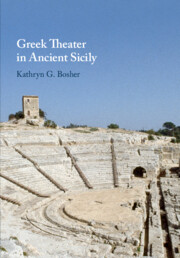64 results
Bibliography
-
- Book:
- Greek Theater in Ancient Sicily
- Published online:
- 11 February 2021
- Print publication:
- 21 January 2021, pp 196-217
-
- Chapter
- Export citation
6 - Drama in Public
-
- Book:
- Greek Theater in Ancient Sicily
- Published online:
- 11 February 2021
- Print publication:
- 21 January 2021, pp 160-188
-
- Chapter
- Export citation
Maps
-
- Book:
- Greek Theater in Ancient Sicily
- Published online:
- 11 February 2021
- Print publication:
- 21 January 2021, pp ix-ix
-
- Chapter
- Export citation
Figures
-
- Book:
- Greek Theater in Ancient Sicily
- Published online:
- 11 February 2021
- Print publication:
- 21 January 2021, pp vii-viii
-
- Chapter
- Export citation
Index locorum
-
- Book:
- Greek Theater in Ancient Sicily
- Published online:
- 11 February 2021
- Print publication:
- 21 January 2021, pp 218-220
-
- Chapter
- Export citation
2 - Out of the Shadows
-
- Book:
- Greek Theater in Ancient Sicily
- Published online:
- 11 February 2021
- Print publication:
- 21 January 2021, pp 14-33
-
- Chapter
- Export citation
Copyright page
-
- Book:
- Greek Theater in Ancient Sicily
- Published online:
- 11 February 2021
- Print publication:
- 21 January 2021, pp iv-iv
-
- Chapter
- Export citation
Note to the Reader
-
- Book:
- Greek Theater in Ancient Sicily
- Published online:
- 11 February 2021
- Print publication:
- 21 January 2021, pp xiii-xiv
-
- Chapter
- Export citation
4 - Politics and Propaganda
-
- Book:
- Greek Theater in Ancient Sicily
- Published online:
- 11 February 2021
- Print publication:
- 21 January 2021, pp 80-106
-
- Chapter
- Export citation

Greek Theater in Ancient Sicily
-
- Published online:
- 11 February 2021
- Print publication:
- 21 January 2021
General Index
-
- Book:
- Greek Theater in Ancient Sicily
- Published online:
- 11 February 2021
- Print publication:
- 21 January 2021, pp 221-234
-
- Chapter
- Export citation
5 - Taking Theater Home
-
- Book:
- Greek Theater in Ancient Sicily
- Published online:
- 11 February 2021
- Print publication:
- 21 January 2021, pp 107-159
-
- Chapter
- Export citation
3 - Cult and Circumstance
-
- Book:
- Greek Theater in Ancient Sicily
- Published online:
- 11 February 2021
- Print publication:
- 21 January 2021, pp 34-79
-
- Chapter
- Export citation
Foreword
-
- Book:
- Greek Theater in Ancient Sicily
- Published online:
- 11 February 2021
- Print publication:
- 21 January 2021, pp xi-xii
-
- Chapter
- Export citation
1 - Introduction
-
- Book:
- Greek Theater in Ancient Sicily
- Published online:
- 11 February 2021
- Print publication:
- 21 January 2021, pp 1-13
-
- Chapter
- Export citation
Contents
-
- Book:
- Greek Theater in Ancient Sicily
- Published online:
- 11 February 2021
- Print publication:
- 21 January 2021, pp v-vi
-
- Chapter
- Export citation
Tables
-
- Book:
- Greek Theater in Ancient Sicily
- Published online:
- 11 February 2021
- Print publication:
- 21 January 2021, pp x-x
-
- Chapter
- Export citation
7 - Conclusion
-
- Book:
- Greek Theater in Ancient Sicily
- Published online:
- 11 February 2021
- Print publication:
- 21 January 2021, pp 189-195
-
- Chapter
- Export citation
Chapter 2 - ‘Romantic Poet-Sage of History’
-
-
- Book:
- Herodotus in the Long Nineteenth Century
- Published online:
- 13 March 2020
- Print publication:
- 26 March 2020, pp 46-70
-
- Chapter
- Export citation
References
-
- Book:
- Ancient Theatre and Performance Culture Around the Black Sea
- Published online:
- 12 November 2019
- Print publication:
- 28 November 2019, pp 490-541
-
- Chapter
- Export citation



